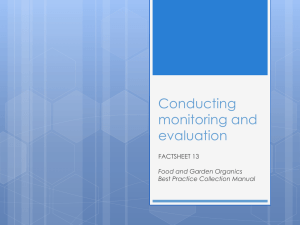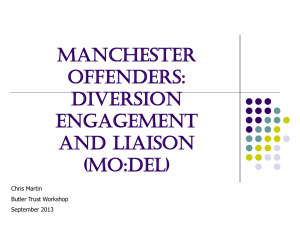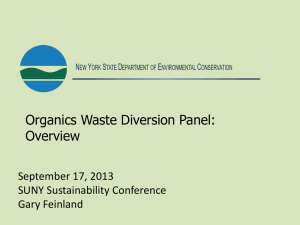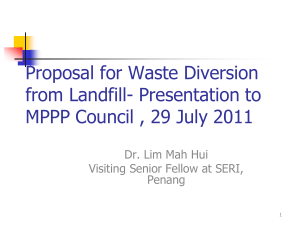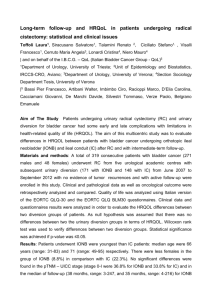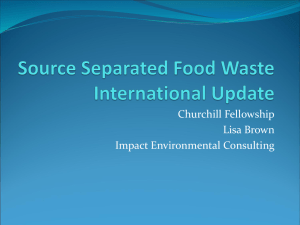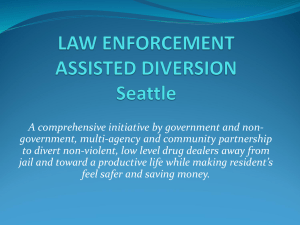Q: Does the City currently have an organics
advertisement
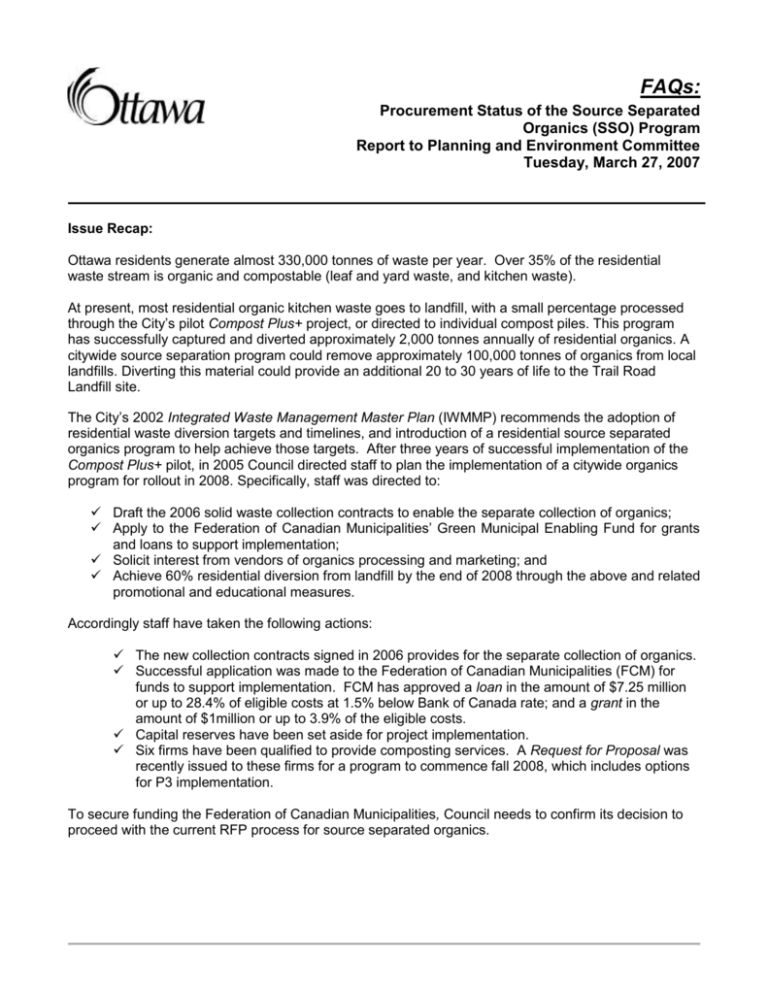
FAQs: Procurement Status of the Source Separated Organics (SSO) Program Report to Planning and Environment Committee Tuesday, March 27, 2007 Issue Recap: Ottawa residents generate almost 330,000 tonnes of waste per year. Over 35% of the residential waste stream is organic and compostable (leaf and yard waste, and kitchen waste). At present, most residential organic kitchen waste goes to landfill, with a small percentage processed through the City’s pilot Compost Plus+ project, or directed to individual compost piles. This program has successfully captured and diverted approximately 2,000 tonnes annually of residential organics. A citywide source separation program could remove approximately 100,000 tonnes of organics from local landfills. Diverting this material could provide an additional 20 to 30 years of life to the Trail Road Landfill site. The City’s 2002 Integrated Waste Management Master Plan (IWMMP) recommends the adoption of residential waste diversion targets and timelines, and introduction of a residential source separated organics program to help achieve those targets. After three years of successful implementation of the Compost Plus+ pilot, in 2005 Council directed staff to plan the implementation of a citywide organics program for rollout in 2008. Specifically, staff was directed to: Draft the 2006 solid waste collection contracts to enable the separate collection of organics; Apply to the Federation of Canadian Municipalities’ Green Municipal Enabling Fund for grants and loans to support implementation; Solicit interest from vendors of organics processing and marketing; and Achieve 60% residential diversion from landfill by the end of 2008 through the above and related promotional and educational measures. Accordingly staff have taken the following actions: The new collection contracts signed in 2006 provides for the separate collection of organics. Successful application was made to the Federation of Canadian Municipalities (FCM) for funds to support implementation. FCM has approved a loan in the amount of $7.25 million or up to 28.4% of eligible costs at 1.5% below Bank of Canada rate; and a grant in the amount of $1million or up to 3.9% of the eligible costs. Capital reserves have been set aside for project implementation. Six firms have been qualified to provide composting services. A Request for Proposal was recently issued to these firms for a program to commence fall 2008, which includes options for P3 implementation. To secure funding the Federation of Canadian Municipalities, Council needs to confirm its decision to proceed with the current RFP process for source separated organics. Frequently Asked Questions Questions and Answers Q. Why does the City need a Source Separated Organics program? A: The Province has stated its intention to mandate 60% residential waste diversion rates, with mandatory diversion of organics as the intended means to achieving that target. Over 3.5 million people in thirteen Ontario cities participate in source separated organics programs. Some cities, like the Region of Markham and York, are already diverting over 70% of their waste. Landfilling organic wastes has been banned in several European countries for over a decade, with Prince Edward Island and Nova Scotia recently following suit. Council will be required to make several decisions concerning waste management over the coming year and it is important that cost information is available that allows for informed decision-making. Staff recommend that the current RFP process continue for the following reasons: The City will forfeit $8.25 million in a grant and loan from the Federation of Canadian Municipalities (FCM) if it does not accept the funding and commit to citywide organics implementation by May 30, 2007, and expend the monies by December 31, 2008. It is possible that one or more facilities could be operational by the Fall of 2008. Diverting organics from landfill will help to mitigate odour generation at local landfills while reducing Green House Gas (GHG) emissions. If competitive prices are obtained, it will be possible to implement the program at the end of 2008. The City’s target of 60% residential diversion could be fully achieved in 2009, with the 2008 SSO deployment. Priced proposals will provide a basis for comparison between SSO processing and other processing and disposal technologies currently under review. Pursuit of an SSO program is in keeping with Provincial direction and industry best management practices, and the City’s IWMMP. Q: How much will the Source Separated Organics Program cost? A: Capital costs to implement the SSO program are estimated at between $15 million and $25 million to be incurred in 2008. Capital reserves in the Solid Waste Compensation Reserve Fund in the amount of $27.3 million as of December 31, 2006 have been set-aside for this purpose. Annual operating costs will depend upon the bids received, i.e. cost per tonne to process the organics. Staff made an application to the FCM for 2006 funding to help implement the SSO program. A detailed proposal was submitted on 26 June 2006, and the City was notified that the application was approved on December 18, 2006. Specifically, FCM has approved a loan in the amount of $7.25 million or up to 28.4% of eligible costs at 1.5% below Bank of Canada rate; and a grant in the amount of $1 million or up to 3.9% of the eligible costs. This represents approximately 33% of the capital value of the SSO program. The fact that the City secured over 70% of the FCM’s total available budget for loans and 40% of its total grant budget speaks to the high environmental, social, and economic benefits of the SSO project. On February 7, 2007, the City was notified that it has until May 30, 2007 to accept the terms of the loan Page 2 of 7 Frequently Asked Questions and approve the project. One of the terms of the agreement is that the monies be expended by December 31, 2008. Ottawa risks losing these funds if Council does not allow the current RFP process to continue. The RFP is scheduled to close June 14, 2007. Staff will be in a position to report on the proponents(s) representing the best overall value to the City in September. Signing of the FCM agreement will not affect Council’s ability to render a decision on SSO. Q: Does the City currently have an organics program? A: Yes, the City’s Compost Plus+ pilot project, which is in its sixth year of operation, offers collection of household organics to nine (9) communities comprising 5,300 households. The program has successfully captured and diverted approximately 2,000 tonnes annually of residential organics. Experience gained with this pilot has been used to design a citywide program. Given the success of the voluntary program in achieving almost 50% diversion over the past five years, staff is confident that achievement of the 60% diversion rate target is realistic, and that the City could meet this Provincial target. This is supported by survey work undertaken by Decima Research Inc. that found a broad base of support for implementation of a residential source separated organics program, refer to Figure1. Figure 1: Likely Participation in Organic Waste Collection Program, Ottawa definitely 14% 3% likely no don't know 30% 53% Source: Decima Research Inc., 2003 Q: What diversion services does the City currently provide to residents? A: Currently, the City provides the following diversion services to residents; Blue and Black Box recycling; Leaf and yard waste pickup; Backyard Composting; Take-it-Back! Program; Household Hazardous Waste Depots; E-Waste Depot; Compost Plus organics pilot project; Yellow Bag program for small businesses; and Bin delivery and replacement services. Page 3 of 7 Frequently Asked Questions Diverting waste benefits the environment and municipal taxpayers by reducing greenhouse gases, reducing demands for natural resources, and generating revenue. Under the direction of Council, staff is investigating and exploring new methods and technologies that could ease the burden that future tonnes of household and commercial garbage represent for local landfills. This includes searching for new ways to divert industrial, commercial and institutional (IC&I) waste, as well as improving household diversion through current recycling and municipal compost programs. Q: Does the City need a stronger diversion strategy? A: Yes, landfills are nearing capacity throughout Ontario, and new or expanded facilities are not only costly, but also increasingly unacceptable to the public and difficult to locate. Ottawa will have a landfill disposal capacity shortfall within 10 years unless further action is taken to do more to increase diversion, implement other processing and disposal methods or expand landfills. Launched last spring, the City’s RETHINK GARBAGE campaign is an education and awareness program that asks residents to ‘rethink’ their attitudes towards garbage, from how much they generate, to their choices for disposal. By encouraging residents to make better use of existing waste diversion programs, the City aims to increase residential diversion from 33% to 40%. The City has plans to introduce a curbside organics program in 2008. This program is expected to improve our diversion rate towards the Provincial target of 60%. As Ottawa makes progress towards achieving its residential target, attention is turning to the IC&I waste stream. The City is asking what more can be done within the IC&I sector and what role the City can play to improve the diversion of all types of waste from local landfills. Q. How much of the City’s total waste is generated in the home vs. by industry and other sectors? A: In 2005, it was estimated that area businesses and institutions generated about 700,000 tonnes of IC&I waste, while 330,000 tonnes of residential waste was collected. This means that approximately 31% of total waste collected in the City is generated in the home. The Blue and Black Box, and Leaf and Yard Waste programs diverted approximately 33% of this residential waste away from landfill. Of the 700,000 tonnes of industrial, commercial and institutional waste (IC&I), approximately 20% is diverted from landfill. Q. How many landfills are located in the Ottawa area and what type of waste do they receive? A: The City owns two landfills, one at Trail Road and the other at Springhill, located in the former township of Osgoode. Trail Road receives residential waste, or about 16% of total waste generated within the City. Page 4 of 7 Frequently Asked Questions Springhill landfill receives Construction & Demolition (C&D) and contaminated soils, amounting to about 7% of total waste. Carp landfill is privately owned by Waste Management Corp. of Canada and receives IC&I, residential and some C&D waste, totalling 39% of the City’s waste. Navan landfill is privately owned by Waste Services and receives only IC&I and C&D waste, amounting to 37% of the City’s total waste. Laflèche Environmental Inc. owns the Moose Creek landfill. Located outside of Ottawa, this site receives residential, IC&I and C&D waste, amounting to 1% of total City waste. Q: Does Ottawa have enough landfill capacity for the future? A: No, Ottawa residents and businesses generate approximately 1 million tonnes of solid waste annually. What is not recycled or otherwise diverted is called “residual” waste, and ends up in local landfills. If diversion rates do not improve (e.g. SSO, mixed waste processing, and IC&I diversion programs), proposed landfill expansions do not occur, and energy from waste technologies are not yet commissioned Ottawa will face a shortage of disposal capacity within 10 years. See figure below. Source: Solid Waste Services, 2005 The City has protected the Trail Road Landfill capacity for "residential" waste to approximately 2030. The private landfills in Ottawa typically accept the majority of waste from the IC&I sector. If these private landfills do not expand and the IC&I waste is landfilled at Trail Road, there will be a significant impact on the life span of the Trail Road Landfill Facility. Page 5 of 7 Frequently Asked Questions Developing a new landfill site is costly - up to $120 million to develop a facility. Diversion programs, like source separated organics program will defer those costs for up to thirty years. Q: What are the environmental implications of implementing an organics program? A: Organics are the primary source of odours at landfills and their removal helps diminish odour issues at local landfills. A citywide source separation program could remove approximately 100,000 tonnes of organics going to landfill. Local development of this technology could facilitate diversion of food wastes originating from restaurants, grocers, hotels etc.—potentially diverting another 70,000 tonnes/year from landfill. Diverting this material could provide an additional 20 to 30 years of life to the Trail Road landfill site. Staff is currently exploring ways to evaluate the relative environmental impacts of major waste processing and disposal management practices on a system-wide basis. A triple bottom line evaluation methodology (environmental, financial and societal assessments) will be developed and applied during the Residual Waste Management Study. Q: What is the role of the Provincial Government in setting waste diversion rates? A: The City has a legislated mandate to provide solid waste collection and diversion (recycling) for the residential sector only. The Province maintains responsibility for overall waste management, including waste diversion for the IC&I sector. In June 2004, the Province issued Ontario’s 60% Waste Diversion Goal: A Discussion Paper, which sets out several approaches the Province is contemplating for the regulation of Ontario wastes. Key matters of note in the Discussion Paper are the following: “Diversion of organics through composting must be enhanced” to reach 60% diversion; and, “in the residential sector, the largest gains are likely to come from increased diversion of organics, both food and yard waste.” The Province indicates that it may phase-in a waste diversion target of 60% by 2008 for municipalities with greater than 250,000 people: “These municipalities already have limited centralized composting infrastructure in place or have plans to develop centralized composting in the near future.” Recently, energy from waste has attracted significant interest as a way to address the shortage of landfill capacity in the Province. At this time, the Provincial Discussion Paper states that energy from waste is a means of “disposal”, not a means of waste “diversion”. In 2005, Council directed that staff undertake steps to enable citywide implementation of a household kitchen organics collection program in keeping with the 60% diversion target. Page 6 of 7 Frequently Asked Questions Q: Is the City looking into new waste processing and disposal technologies? A: Yes, last year the City issued a Request for Expressions of Interest for waste technologies and ten submissions were received. A review of waste disposal technologies is being completed and Council approval will be requested this spring. The review will assess a list of disposal technologies, and recommend a shortlist of technologies considered suitable for Ottawa’s waste needs. Gasification, as well as landfilling, will be included on the list, considering that the City has current programs and a test facility in place. Q: Can new waste processing and disposal technologies eliminate the need for diversion strategy? A: No, municipalities across Canada and around the world have determined that the best current course of actions is to continue to research and develop new waste disposal technologies and simultaneously pursue all options to improve diversion. SSO programs have been implemented by thirteen municipalities in Ontario, and serve over 3.5 million people. Contacts: Departmental Lead/Spokesperson: Kenneth J. Brothers (ext. 22609) Page 7 of 7
